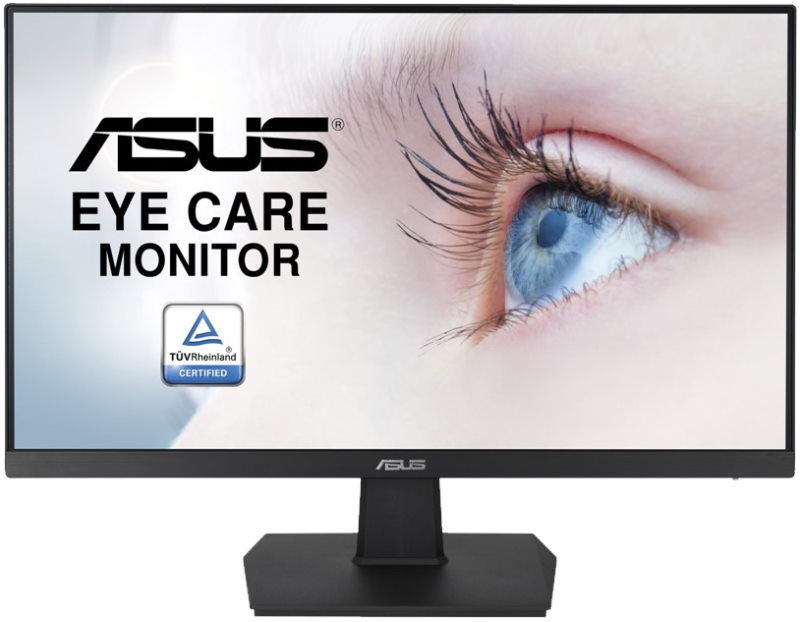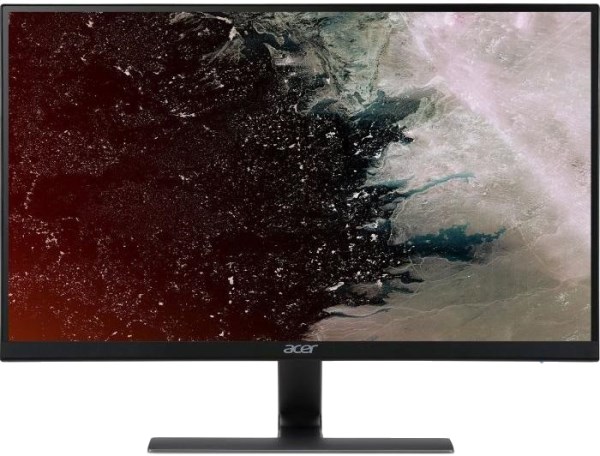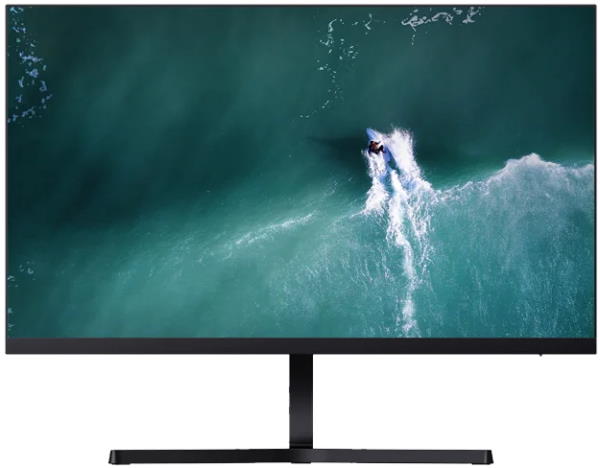When you need a bigger size: TOP 5 monitors paired with a laptop

In this material, we have collected five inexpensive, but high-quality 24-inch models that will do an excellent job of this task. In a special table, you can compare all five 24-inch monitor models from the review. And at the link you will find the entire catalog of monitors.
The Chinese brand Xiaomi is slowly but surely moving towards the title of the main manufacturer of any electronics that a person has just come up with. Recently, they have been actively spudding the market for laptops, computers and components, and more recently they have been noted as a manufacturer of monitors. Their new brainchild came out under the flags of the Redmi brand and stands out with guess what. That's right, low price. Official price 99 euros. In domestic retail, a little more expensive, but still this is one of the most affordable models with a 24-inch price tag. The question is, what did you save on and “is it top for your money”?
The monitor is assembled on the basis of a 24-inch Full HD IPS-matrix, which provides a maximum image brightness of 250 nits and a contrast ratio of 1000:1. To reduce eye strain, Flicker-Free features are provided to eliminate backlight flicker and Low Blue Light, which reduces the amount of blue tints. Freesync and a high refresh rate for a consumer monitor are overkill, so they are not expected here. By the standards of low-cost monitors, color reproduction and picture quality are at a fairly high level here, the image looks natural and without an overabundance of colors. To be honest, the matrix pleasantly surprised us, we were expecting more modest results. You can connect Redmi Display 1A to a computer or laptop using VGA and HDMI interfaces. By the way, the HDMI version here is not 1.4, as in other inexpensive monitors, but more modern 2.0. Given the low-cost of the monitor, this is not God knows what an advantage, but it would be wrong to bypass it.
It is unlikely that after reading this paragraph you will have the desire to rush to the store for him. Moreover, we met the same characteristics in the recent Xiaomi Mi Display 1A. Xiaomi has thoroughly studied the market and realized that cheap monitors are usually ugly, and beautiful ones are expensive. It didn’t take long to think and they made a really beautiful low-cost monitor: almost frameless, with a nice-looking matte plastic and a stylish curved tripod-shaped stand. The design of the monitor from Redmi is reminiscent of another low-cost hit AOC 22V2Q, which had a noticeable frame only at the bottom, and the sides had to be viewed with a magnifying glass. From the side, Redmi Display 1A looks impressive, because its thickness is only 7.3 mm, and this, for a second, is thinner than most modern smartphones. In addition to the visual effect, this feature is also functional in nature, allowing you to combine multiple monitors into one giant display. The only thing that can upset this monitor is the plug without an adapter.

The hero of today's review, 246E9QDSB belongs to the updated line of Philips monitors in 2018. It combines a stylish appearance, decent functionality and an excellent matrix by the standards of inexpensive monitors. The 246E9QDSB is based on a 24-inch IPS panel with Full HD (1920x1080) resolution, good response speed and standard brightness (250 cd/m2). The viewing angles of the monitor are excellent vertically, but so-so horizontally: as soon as you deviate slightly to the side, the picture fades and the backlight unevenness becomes more distinct.
Problems with uneven backlighting or the glow effect affect almost any inexpensive monitor in one way or another, the question is how much they manifest themselves. Philips 246E9QDSB is tolerant of this. The most interesting thing here is excellent color reproduction, which is not often found in the sub-$150 segment. The monitor is capable of displaying 129% of the sRGB color space, providing a really bright, colorful and juicy picture. With a little fiddling with the settings and calibration, he is quite capable of becoming an assistant designer, photographer and artist. It is clear that this is not the level of a professional graphics monitor, but much more interesting than many very cheap displays, which are at best designed for typing.
At the same time, it copes quite well with the role of a not too pretentious multimedia monitor for video games and movies. The matrix speed is an adequate 5 ms, a refresh rate of 75 Hz should be enough for undemanding gamers (everyone else only 144 Hz), and AMD FreeSync support will not allow dynamic frames to be torn apart. A great option for an inexpensive gaming PC that doesn't require esports feats. In addition, the Philips 246E9QDSB looks quite modern: the frames on the sides and top are barely noticeable, and the thick bottom edge makes the design solid. A graceful metal leg only emphasizes the image, giving it completeness. To connect to a signal source, analog VGA and digital DVI with HDMI are used, and instead of a stand, the monitor can be attached to the wall using VESA mounts.

| Ctrs.com.ua | 4 999 ₴ | To Store |
| Onekit.com.ua | 5 909 ₴ | To Store |
| Technoceh.com | 4 999 ₴ | To Store |
| Rozetka.ua | 4 470 ₴ | To Store |
As monitor sales statistics show, most people care little about the intricacies of image reproduction or the nuances of monitor color reproduction. Here's my money. Make the size bigger, the picture more pleasant, the load on the eyes is less, so that it is comfortable to work or watch a movie. If you belong to this category of people, then pay attention to the fresh 24-inch model Asus VA24EHE.
Despite the classification “gaming monitor”, we have rather a high-quality everyday model with thin frames, which is suitable for pairing with a desktop computer or a tiny ultrabook, the diagonal of which is not enough for comfortable work. The Asus VA24EHE features a 24-inch Full HD display. The display is based on an IPS-matrix with W-LED backlighting, a standard margin of brightness for this class and a fairly high contrast ratio. The monitor demonstrates a rich and colorful picture for its class, the default color accuracy leaves much to be desired, but this is quite simply solved by choosing the modes and setting them up in the menu. In general, in terms of settings, it is quite “capricious”, in order to get the maximum, we recommend taking the time to adjust the picture. You will especially have to tinker with the display of black.
It would be wrong to talk about a full-fledged gaming monitor, but several factors still allow the manufacturer to call this model a gaming one. First, its sweep frequency is 75 Hz. This is not a full-fledged 120 - 144 Hz, but not the base 60 Hz, as in conventional office monitors. Secondly, the matrix is moderately fast (response time is 5 ms) and supports the popular AMD FreeSync anti-aliasing technology, which prevents dynamic frames from being “torn” into pieces. Thirdly, as a legacy from the more expensive Asus models, the hero of our review received several branded game features that allow you to display the FPS counter, timer and sniper scope on the display. Summing up, I would like to warn that Acer turned out to be a decent low-cost monitor, but you should not expect some kind of wow effect from it. Especially if you are attracted by the "gaming monitor" feature.

| Onekit.com.ua | 7 502 ₴ | To Store |
What do we need from a modern gaming monitor? The sweep frequency is higher than the standard 60 Hz. Ideally 120 - 144. What else? To make the matrix fast, no more than 5 ms. Well, don't forget about support for useful things like AMD FreeSync. However, the market is full of inexpensive models that do not fully meet these requirements, but are called gaming. For example, the hero of this review, the Acer RG240Ybmiix, belongs to the popular Nitro gaming line, but the refresh rate does not exceed 75 Hz.
To some extent, the RG240Ybmiix even exceeds expectations, for example, the response time of its matrix is only one millisecond. It is clear that this is not pure 1 ms, as in expensive gaming monitors (it was calculated taking into account Visual Response Boost technology), but for not the fastest IPS matrices this is a good result. Well, do not forget that this handsome man costs about $150, and models with fast matrices do not swim in these waters at all. Otherwise, the Acer Nitro looks quite modern: the 24-inch matrix displays a picture with FullHD resolution, and the brightness, contrast and color performance are at an adequate level for this class. Despite the fact that in fact the matrix here is not 8-bit, but 6-bit + FRC, the picture looks pretty nice, although there is a slight backlight unevenness, especially noticeable in the corners against a dark background.
If we put it on the table with one of last year's Nitro models, we will see that the main improvements have affected not so much the matrix itself, but the design. Older models flirted more with the concept of "gaming design" and sported all sorts of decorative inserts (of course in red), the new one looks more versatile and modern. The side frames have remained the same thin, the decor has become smaller, the stand looks less aggressive, and the monitor itself has become much thinner - in some places the thickness reaches only 7 mm. Tolstoy remained only the hardware with the power supply, built-in speakers and video outputs. By the way, instead of one HDMI port, the RG240Ybmiix has two.

| Kvshop.com.ua | 4 999 ₴ | To Store |
The Samsung S24R650F monitor uses a 24-inch IPS matrix with a resolution of 1920x1080 pixels. The display features modest, but sufficient for most usage scenarios, color gamut (72% NTSC), standard brightness settings (250 cd/m2) and statistical contrast ratio (1000:1). Flicker-Free technology (eliminates the effect of screen flicker) and Eye Saver Mode (minimizes the intensity of blue light) are on the protection of vision. It is quite difficult to objectively assess the image quality, since most 24-inch IPS panels under $150 look plus or minus the same, and frankly terrible or vice versa cool matrices are rare. The Samsung S24R650F is good in this regard, but also not perfect: it pleases with good color reproduction and natural shades, but it's a little frustrating due to small highlights from the bottom of the screen. Fans of dynamic content will appreciate the refresh rate of 75 Hz, the response speed of the matrix 5 ms and the presence of features AMD FreeSync.
The monitor also offers a wide choice of interfaces for connection, including HDMI, DisplayPort version 1.2 and VGA, as well as a full-fledged USB hub with four ports, one of which supports the charging function. Considering that laptop manufacturers are constantly greedy with USB ports, sometimes cutting their number down to two (yes, we're talking about you, Apple), this can be a significant plus for laptop owners. Moreover, a high-quality hub for 3-4 ports from a conditional Satechi will cost almost half the price of this monitor. The advantages of the model also include a modern appearance with barely noticeable side frames that allow you to visually “stitch” several of these displays into one large screen.
Finally, be sure to pay attention to the stand. On the one hand, it allows you to adjust the monitor to your heart's content: tilt or rotate comfortably, move the leg in search of the perfect height, or rotate the screen vertically, up to portrait mode. For an inexpensive model with a price tag of around $150, this is a rather rare option. On the other hand, Samsung often has a problem with flimsy stands and the Samsung S24R650F is no exception. If the table staggers, then the monitor immediately begins to sway, and the leg itself does not give the impression of a reliable support. Therefore, many users buy this model with the expectation of hanging it on the wall, since it has VESA wall mounts.
Articles, reviews, useful tips
All materials































